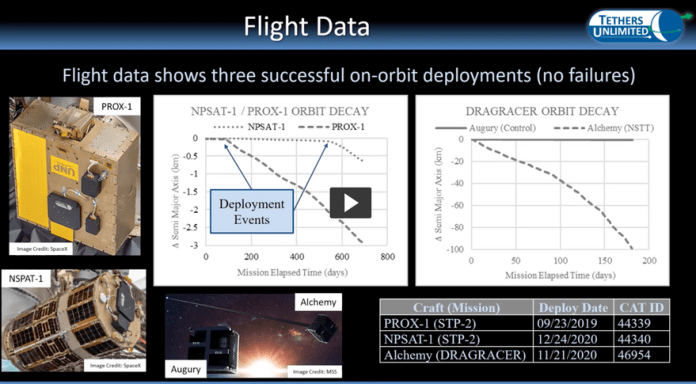
Electrodynamic tethers speed up satellite reentry timelines (Image Credit: SNN)

SAN FRANCISCO – Tethers Unlimited’s Terminator Tape lowered a cubesat into Earth’s atmosphere in eight months, while a nearly identical satellite without a 70-meter conductive tail is expected to remain in orbit for more than a decade.
A paper presented at the virtual Small Satellite Conference described three Terminator Tape deployments and offered convincing evidence that the technology can dramatically speed up satellite reentry, said Rob Hoyt, Tethers Unlimited founder and president.
Hoyt’s hope is that people will employ tethers to help clean up the low Earth orbit (LEO) environment.
“With the population of satellites in LEO growing rapidly and projected to grow even more rapidly over the next decade, removing spent satellites as soon as possible will provide significant reductions in risks for debris-generating collisions,” Hoyt told SpaceNews.
The Tethers Unlimited presentation covered the deployment of Terminator Tapes on three satellites: Alchemy, the Naval Postgraduate School’s NPSat-1 and Prox-1, a satellite built by the Georgia Institute of Technology with funding from the U.S. Air Force Research Laboratory.
Alchemy and its twin satellite Augury were launched in November 2020 as part of the Dragracer mission, a campaign by Millennium Space Systems, TriSept Corp., Tethers Unlimited and Rocket Lab to measure the impact of an electrodynamic tether.
After Alchemy and Augury were launched on a Rocket Lab Electron and deployed in a 500-kilometer orbit, Alchemy activated its Terminator Tape. Eight months later, on July 19, 2021, Alchemy reentered Earth’s atmosphere. Augury is expected to follow sometime between 2032 and 2037.
With data from the three missions, Tethers Unlimited is refining its predictions of satellite deorbit rates.
Prox-1 and NPSat-1, launched in June 2019, remain in orbit. Prox-1 released its Terminator Tape 90 days after its mission began. NPSat-1 deployed its Terminator Tape after 18 months.
Both missions moved to lower altitudes soon after their tethers were deployed. While they remain in orbit, the deorbit speeds for Prox-1 and NPSat-1 will increase with heightened solar activity over the next few year, said Harrison Stankey, Tethers Unlimited mechanical engineer, said Aug. 10 at the Small Satellite Conference.
Solar conditions have an important impact on Terminator Tapes, which rely on passive interactions with the neutral particles in the upper atmosphere and the ionospheric plasma to generate drag, Hoyt said.
“Decay rates for all spacecraft are more than an order of magnitude higher after deployment of the Terminator Tape,” Stankey said. “Terminator Tape has shown its effectiveness as a deorbit device.”
– Advertisement –





